Allosteric covalent - Study guides, Class notes & Summaries
Looking for the best study guides, study notes and summaries about Allosteric covalent? On this page you'll find 366 study documents about Allosteric covalent.
Page 3 out of 366 results
Sort by
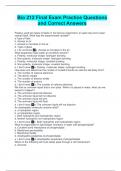
-
Bio 212 Final Exam Practice Questions and Correct Answers
- Exam (elaborations) • 30 pages • 2024
-
Available in package deal
-
- $13.99
- + learn more
Pasteur used two types of flasks in his famous experiment: an open-top and a swan-necked flask. What was the experimental variable? a.Type of flask b. Access to air c. Access to microbes in the air d. Type of glass e. I do not know c. Access to microbes in the air What properties make water an excellent solvent? a. Polarity, molecular shape, hydrogen bonding b. Non-polarity, molecular shape, hydrogen bonding c. Polarity, molecular shape, covalent bonding d. Non-polarity, molecular sha...
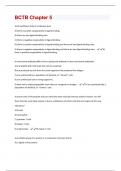
-
BCTB Chapter 5 Questions And Answers With Latest Quiz
- Exam (elaborations) • 21 pages • 2024
- Available in package deal
-
- $7.99
- + learn more
A Hill coefficient (nH) of 2 indicates that: A) there is positive cooperativity in ligand binding. B) there are two ligand-binding sites. C) there is negative cooperativity in ligand binding. D) there is positive cooperativity in ligand binding and there are two ligand-binding sites. E) there is negative cooperativity in ligand binding and there are two ligand-binding sites. - A) there is positive cooperativity in ligand binding. A monoclonal antibody differs from a polyclonal antibody in...
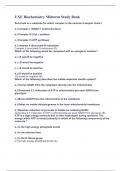
-
UNE Biochemistry Midterm Study Bank
- Exam (elaborations) • 20 pages • 2024
-
- $11.99
- + learn more
UNE Biochemistry Midterm Study Bank Succinate is a substrate for which complex in the electron transport chain? a.) Complex 1 (NADH-1 oxidoreductase) b.) Complex IV (Cyt c oxidase) c.) Complex V (ATP synthase) d.) complex II (Succinate-Q reductase) Complex II (succinate-Q reductase) (D) Which of the following would be consistent with an exergonic reaction? a.) ∆S would be negative b.) ∆G would be negative c.) ∆S would be positive d.)∆G would be positive ∆G...

-
UNE Biochemistry Midterm Study Bank
- Exam (elaborations) • 20 pages • 2024
-
- $13.49
- + learn more
UNE Biochemistry Midterm Study Bank Succinate is a substrate for which complex in the electron transport chain? a.) Complex 1 (NADH-1 oxidoreductase) b.) Complex IV (Cyt c oxidase) c.) Complex V (ATP synthase) d.) complex II (Succinate-Q reductase) Complex II (succinate-Q reductase) (D) Which of the following would be consistent with an exergonic reaction? a.) ∆S would be negative b.) ∆G would be negative c.) ∆S would be positive d.)∆G would be positive ∆G...

-
UNE Biochemistry Midterm Study Bank Questions With Actual Solutions.
- Exam (elaborations) • 20 pages • 2024
-
- $10.99
- + learn more
UNE Biochemistry Midterm Study Bank Questions With Actual Solutions. Succinate is a substrate for which complex in the electron transport chain? a.) Complex 1 (NADH-1 oxidoreductase) b.) Complex IV (Cyt c oxidase) c.) Complex V (ATP synthase) d.) complex II (Succinate-Q reductase) Complex II (succinate-Q reductase) (D) Which of the following would be consistent with an exergonic reaction? a.) ∆S would be negative b.) ∆G would be negative c.) ∆S would be positive ...
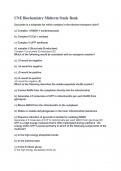
-
UNE Biochemistry Midterm Study Bank
- Exam (elaborations) • 20 pages • 2024
-
- $10.49
- + learn more
UNE Biochemistry Midterm Study Bank Succinate is a substrate for which complex in the electron transport chain? a.) Complex 1 (NADH-1 oxidoreductase) b.) Complex IV (Cyt c oxidase) c.) Complex V (ATP synthase) d.) complex II (Succinate-Q reductase) Complex II (succinate-Q reductase) (D) Which of the following would be consistent with an exergonic reaction? a.) ∆S would be negative b.) ∆G would be negative c.) ∆S would be positive d.)∆G would be positive ∆G...
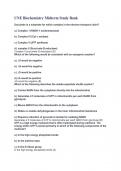
-
UNE Biochemistry Midterm Study Bank
- Exam (elaborations) • 20 pages • 2024
-
- $12.49
- + learn more
UNE Biochemistry Midterm Study Bank Succinate is a substrate for which complex in the electron transport chain? a.) Complex 1 (NADH-1 oxidoreductase) b.) Complex IV (Cyt c oxidase) c.) Complex V (ATP synthase) d.) complex II (Succinate-Q reductase) Complex II (succinate-Q reductase) (D) Which of the following would be consistent with an exergonic reaction? a.) ∆S would be negative b.) ∆G would be negative c.) ∆S would be positive d.)∆G would be positive ∆G...
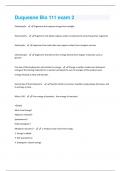
-
Duquesne Bio 111 exam 2 Updated Exam!!
- Exam (elaborations) • 6 pages • 2024
- Available in package deal
-
- $7.99
- + learn more
Phototrophs - Organisms that capture energy from sunlight Heterotrophs - Organisms that obtain organic carbon compounds by consuming other organisms Autotrophs - organisms that make their own organic carbon from inorganic sources Chemotrophs - Organisms that derive their energy directly from organic molecules such as glucose First law of thermodynamics and relation to energy - Energy is neither created nor destroyedenergy of the starting materials for a reaction will equal the sum of energi...
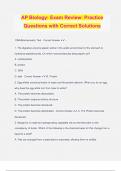
-
AP Biology: Exam Review: Practice Questions with Correct Solutions
- Exam (elaborations) • 83 pages • 2024
-
- $14.49
- + learn more
AP Biology: Exam Review: Practice Questions with Correct Solutions DNA/Biochemestry Test - Correct Answer ️️ --- 1. The digestive enzyme pepsin works in the acidic environment of the stomach to hydrolyze peptide bonds. On which macromolecules does pepsin act? A. carbohydrate B. protein C. DNA D. lipid - Correct Answer ️️ -B. Protein 2. Egg whites consist primarily of water and the protein albumin. When you fry an egg, why does the egg white turn from clear to white? A. The pro...
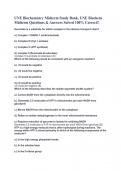
-
UNE Biochemistry Midterm Study Bank, UNE Biochem Midterm Questions & Answers Solved 100% Correct!!
- Exam (elaborations) • 28 pages • 2024
-
- $11.49
- + learn more
UNE Biochemistry Midterm Study Bank, UNE Biochem Midterm Questions & Answers Solved 100% Correct!! Succinate is a substrate for which complex in the electron transport chain? a.) Complex 1 (NADH-1 oxidoreductase) b.) Complex IV (Cyt c oxidase) c.) Complex V (ATP synthase) d.) complex II (Succinate-Q reductase) Complex II (succinate-Q reductase) (D) Which of the following would be consistent with an exergonic reaction? a.) ∆S would be negative b.) ∆G would be negative ...

Do you wonder why so many students wear nice clothes, have money to spare and enjoy tons of free time? Well, they sell on Stuvia! Imagine your study notes being downloaded a dozen times for $15 each. Every. Single. Day. Discover all about earning on Stuvia


